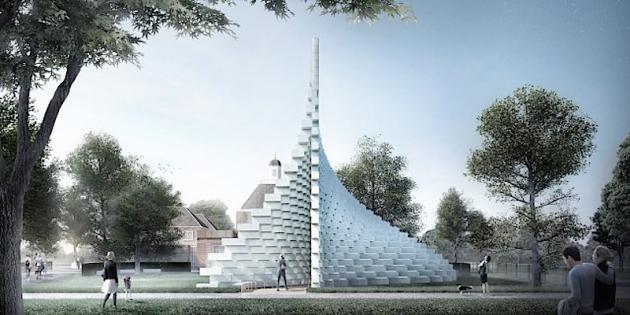The Serpentine has unveiled the designs for its expanded Architecture Programme for 2016: the 16th annual Pavilion designed by Bjarke Ingels Group (BIG) (Copenhagen/New York) and four newly commissioned Summer Houses by Kunlé Adeyemi – NLÉ (Amsterdam/Lagos), Barkow Leibinger (Berlin/New York), Yona Friedman (Paris) and Asif Khan (London). The Summer Houses are inspired by Queen Caroline’s Temple, a classical style summer house built in 1734 and a stone’s throw from the Serpentine Gallery.
Introducing contemporary architecture to a wider audience, the Serpentine Architecture Programme presents a unique exhibition of contemporary international architecture in the built form, rather than through an exhibition of models, drawings and plans. Each of the five architects, aged between 36 and 93, have not completed a permanent structure in the UK.
The Serpentine Pavilion, designed by Bjarke Ingels Group (BIG), is an ‘unzipped wall’ that is transformed from straight line to three-dimensional space, creating a dramatic structure that by day houses a café and free family activities and by night becomes a space for the Serpentine’s acclaimed Park Nights programme of performative works by artists, writers and musicians. Kunlé Adeyemi’s Summer House is an inverse replica of Queen Caroline’s Temple – a tribute to its robust form, space and material, recomposed into a new sculptural object. Barkow Leibinger were inspired by another, now extinct, 18th Century pavilion also designed by William Kent, which rotated and offered 360 degree views of the Park. Yona Friedman’s Summer House takes the form of a modular structure that can be assembled and disassembled in different formations and builds upon the architect’s pioneering project La Ville Spatiale (Spatial City) begun in the late 1950s. Asif Khan’s design is inspired by the fact that Queen Caroline’s Temple was positioned in a way that it would allow it to catch the sunlight from The Serpentine lake.
Serpentine Galleries Director, Julia Peyton-Jones, and Co-Director, Hans Ulrich Obrist, said: “We are delighted to reveal the designs for our expanded Architecture Programme. As you can see from the architect’s renders, Bjarke Ingels has responded to the brief for a multi-purpose Pavilion with a supremely elegant structure that is both curvaceous wall and soaring spire, that will surely serve as a beacon – drawing visitors across Hyde Park and Kensington Gardens to visit the Pavilion, the Summer Houses and our major exhibitions by Alex Katz and Etel Adnan. The response to design a Summer House inspired by the 18th Century Queen Caroline’s Temple by our four international architects has been equally inspired and has produced four unique spaces for visitors to explore this summer. “
Serpentine Pavilion 2016 Designed by Bjarke Ingels Group (BIG) See Top Photo
Bjarke Ingels Group (BIG): For the Serpentine Pavilion 2016, we have attempted to design a structure that embodies multiple aspects that are often perceived as opposites: a structure that is free-form yet rigorous, modular yet sculptural, both transparent and opaque, both solid box and blob. We decided to work with one of the most basic elements of architecture: the brick wall. Rather than clay bricks or stone blocks, the wall is erected from extruded fibreglass frames stacked on top of each other. The wall is then pulled apart to form a cavity within it, to house the events of the Pavilion’s programme. This unzipping of the wall turns the line into a surface, transforming the wall into a space. A complex three-dimensional environment is created which can be explored and experienced in a variety of ways, inside and outside. At the top, the wall appears like a straight line, while the bottom, it forms a sheltered valley at the entrance of the Pavilion and an undulating hillside towards the Park.
Serpentine Summer Houses 2016
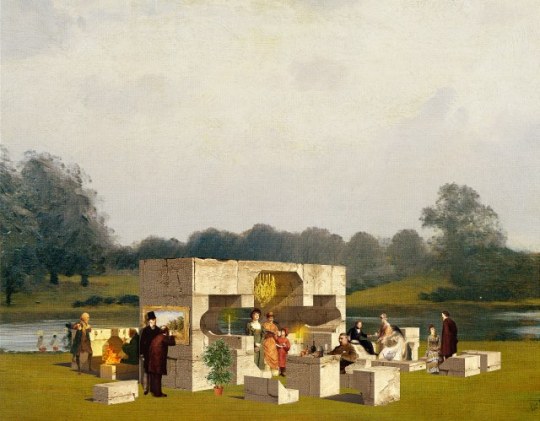
Kunlé Adeyemi – NLÉ: With a play on architecture, our design aims to fulfil the simple primary purpose of a Summer House: a space for shelter and relaxation. The design is based on projecting an inverse replica of the historic Queen Caroline’s Temple – a tribute to its robust form, space and material, recomposed into a bold new sculptural object. By rotating the Temple’s interior void space, we expose the structure’s neo-classical plan, proportions and architectural form. Using prefabricated building blocks assembled from sandstone similar to the ones used in building the Temple, our abstracted forms come together to create a room, a doorway and a window for people to interact with the building, the environment and with one another. By locating the Temple in the proximity of the trees, we offer an extension of the space into the landscape, providing shaded areas in their canopies and in the shadows generated by the object. The carved out void, soft interior and fragmented furniture blocks create comfortable spaces for people to eat, rest or play – in and around the house – all through the summer season.
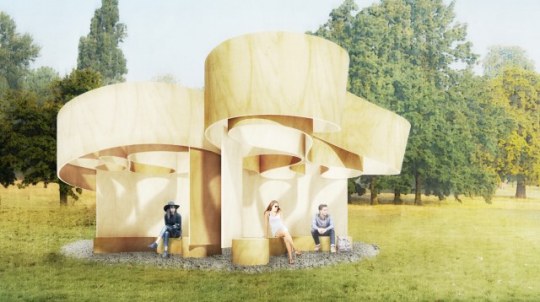
Barkow Leibinger: Queen Caroline’s Temple, an 18th Century historical summer house attributed to William Kent and situated in proximity to the Serpentine Gallery, stands – seemingly without purpose – facing a large meadow. A second Pavilion, today extinct, also designed by Kent was situated on a nearby man-made mountain constructed from the dredging of the artificial The Long Water. This small pavilion rotated mechanically 360 degrees at the top of the hill, offering various panoramic views of the Park and, reciprocally, different views of itself when seen from the Park. It was meant both to be visible in the Park and a structure from which to survey its surroundings. The little mountain and house disappeared at some point in history. With this absent structure in mind, we have designed a Summer House in-the-round. Standing free with all its sides visible, and conceived as a series of undulating structural bands, it is reminiscent of a blind contour drawing (a drawing executed without lifting the pencil up from the paper and only looking at the subject). The logic of generating a structure from loops is a self-generating one and comes from the idea of coiling material in your hands then stacking the coils upon each other. The horizontal banding recalls the layered coursing of Queen Caroline’s Temple, despite its idiosyncratic nature.
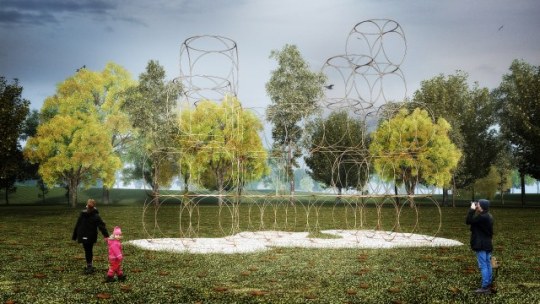
Yona Friedman: The proposed Summer House builds upon my project La Ville Spatiale (Spatial City) begun in the late 1950s. The manifesto for this project, published in 1959, was based on two pillars or principles: firstly, a mobile architecture that could create an elevated city space and enable the growth of cities while restraining the use of land; secondly, the use of modular structures to allow people to live in housing of their own design. The Serpentine Summer House is a ‘space-chain’ structure that constitutes a fragment of a larger grid structure, originally conceived for La Ville Spatiale. It is a modular structure that can be disassembled and assembled in different formations and compositions.
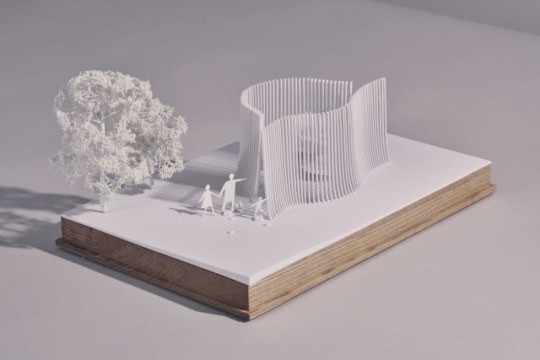
Asif Khan: The Summer House takes a circular form where the circumference has been unpeeled to connect us and the Temple to a picturesque moment left hidden by William Kent almost 300 years ago. Through sun path analysis I realised that Kent aligned the temple toward the direction of the rising sun on 1st March 1683, Queen Caroline’s birthday. This effect would have been amplified by the reflection off the newly created Serpentine lake. We can imagine that The Serpentine lake itself may have been designed to amplify this annual moment, a landscape-sized mirror to reflect the sun, a possibility which John Rennie’s 1826 bridge obscures. In our Summer House a polished metal platform and roof provide an intimate experience of this lost moment for the visitor. Three ‘rooms’ of differing spatial quality gently enfilade together like those in the Temple. These are articulated by an undulating line of timber staves which create enclosure and direct views. The ground is a continuous gravel landscape punctuated by stepping stones, subtly elevating and measuring the visitor’s approach when entering the interior. As the structure meets the gravel it gently blends the horizontal and vertical, to appear as if the Summer House might have grown out of the ground. The project is designed to offer new experiences of the Park through dialogue with Queen Caroline’s Temple and the surrounding scenery
The Serpentine Pavilion is one of the top-ten most visited architectural and design exhibitions in the world. There is no budget for the project, it is realised through sponsorship, help-in-kind support and the sale of the Pavilion.
Serpentine Pavilion History: The Serpentine’s Pavilion commission, conceived in 2000 by Director Julia Peyton-Jones, has become an international site for architectural experimentation and has presented projects by some of the world’s greatest architects. Each Pavilion is sited on the Serpentine Gallery’s lawn for four months and the immediacy of the commission – taking a maximum of six months from invitation to completion – provides a unique model worldwide.
Serpentine Pavilion architects to date are: selgascano, 2015; Smiljan Radić, 2014; Sou Fujimoto, 2013; Herzog & de Meuron and Ai Weiwei, 2012; Peter Zumthor, 2011; Jean Nouvel, 2010; Kazuyo Sejima and Ryue Nishizawa, SANAA, 2009; Frank Gehry, 2008; Olafur Eliasson and Kjetil Thorsen, 2007; Rem Koolhaas and Cecil Balmond, with Arup, 2006; Álvaro Siza and Eduardo Souto de Moura with Cecil Balmond, Arup, 2005; MVRDV with Arup, 2004 (un-realised); Oscar Niemeyer, 2003; Toyo Ito and Cecil Balmond – with Arup, 2002; Daniel Libeskind with Arup, 2001; and Zaha Hadid, 2000.
Summer Houses: The Summer Houses are a significant addition to the Serpentine’s programme of commissioning international architects to design a structure for the Gallery’s lawn as an exhibition of architecture in a built-form. The designs for the Pavilion and Summer Houses consider the relationships between each of the five structures, the Serpentine Gallery building and the landscape of Kensington Gardens.

